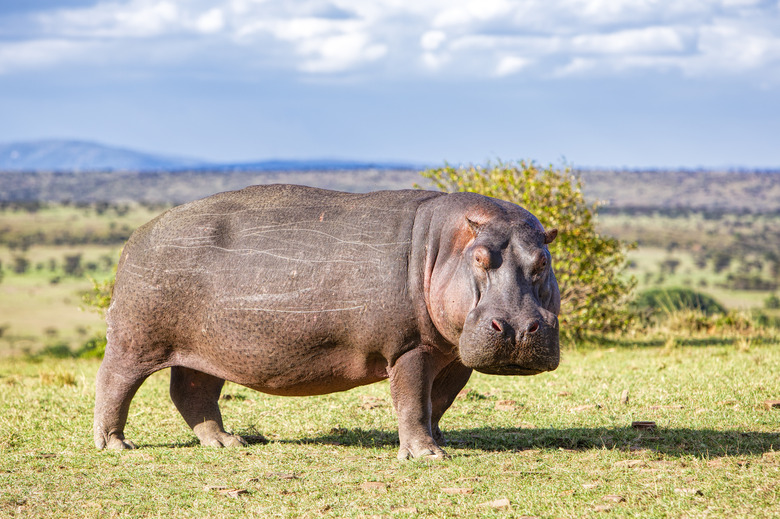What Does A Hippo Eat?
The hippopotamus is the second largest land mammal, with the elephant being the largest. Although hippos have a somewhat docile appearance they can be dangerous and aggressive animals. The appetite of a hippopotamus is not as large as we might expect when compared to its massive size.
Types
Types
There are two types of hippopotamus. The common hippopotamus weighs 3,000 to 9,000 pounds and grows between 10 to 16 ½ feet in length. The pygmy hippopotamus grows to 4 ½ feet in length and weighs 300 to 600 pounds. The pygmy hippopotamus is more partial to land than its river relative. They live mostly in dense forest areas and feed on various types of vegetation.
Features
Features
The common hippopotamus is also referred to as a river horse. Although the hippo is a land mammal it is well adapted to the water. The animal has a clear membrane that covers its eyes to protect them in water and yet allows them to see underwater. Its nostrils close and the hippo can hold its breath for 5 minutes or longer. Although the hippopotamus spends much of its life in water it cannot swim.
Significance
Significance
Both types of hippos are herbivores. Their diet consists mostly of grass and water plants. They spend most of their days lying in shallow water. They spend their nights grazing. Hippos can graze up for up to 6 hours at a time. Hippos usually graze on patches of short grass near shallow water. They also eat hay, alfalfa and find fruit enjoyable. Hippos can consume between 80 to 100 pounds of food daily but when compared to the maximum size of a hippopotamus that is actually a modest amount of food. Hippos lead a fairly sedentary lifestyle which doesn't require a lot of food for energy. The hippopotamus can go up to 3 weeks without eating.
Considerations
Considerations
If a hippopotamus remains out of water for too long it can lead to dehydration. The hippo does not have sweat glands. It secretes a thick red substance from the pores making the hippo look as if it is sweating blood. This substance keeps the animal's skin moist and protects it from sunburn since the hippo spends quite a bit of time basking in the sun.
Function
Function
Hippos can breed on land or in the water. The female hippopotamus gives birth to one offspring after a gestation period of 8 months. The female can give birth on land or in the water. She will nurse her infant for 8 months and can do so underwater as well as on land. The female stays with her infant and will not leave to eat until it is safe for the infant to graze with the mother.
Effects
Effects
The hippopotamus has a lifespan of approximately 45 years. Hippos are social animals who live in groups of 10 to 30 animals. In some instances, a herd of hippos may contain 100 to 200 animals. The herd usually contains a dominant male which can mate with all of the females in the herd. Male hippos will occasionally will assert their dominance by displays of aggressiveness. Although the challenging hippo will normally back down and walk away after a display of dominance occasionally serious injuries or even death will occur. A hippopotamus usually will not bother humans but may attack if provoked or threatened.
Potential
Potential
The common hippopotamus is not endangered but they are threatened. They once roamed throughout Africa but their territory has become smaller due to the progressive movements of humans into the animal's natural habitat. Hippos have also been hunted extensively for both food and their ivory tusks. The pygmy hippopotamus is endangered mostly due to the fact of loss of habitat due to the clearing of forests.
Cite This Article
MLA
Zagata, Darlene. "What Does A Hippo Eat?" sciencing.com, https://www.sciencing.com/what-does-hippo-eat-4689824/. 22 November 2019.
APA
Zagata, Darlene. (2019, November 22). What Does A Hippo Eat?. sciencing.com. Retrieved from https://www.sciencing.com/what-does-hippo-eat-4689824/
Chicago
Zagata, Darlene. What Does A Hippo Eat? last modified March 24, 2022. https://www.sciencing.com/what-does-hippo-eat-4689824/
